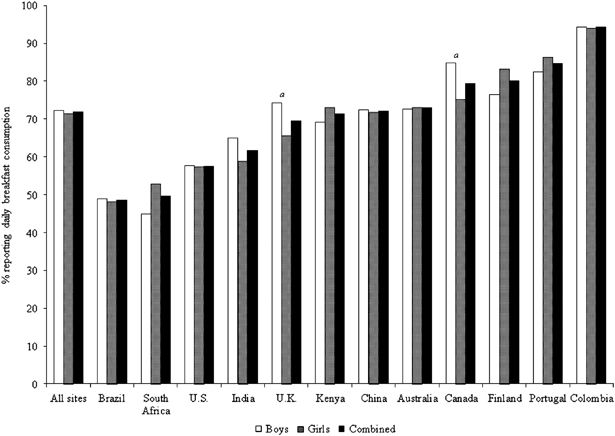International Journal of Obesity Supplements Pub Date : 2015-12-08 , DOI: 10.1038/ijosup.2015.24 J K Zakrzewski , , F B Gillison , S Cumming , T S Church , P T Katzmarzyk , S T Broyles , C M Champagne , J-P Chaput , K D Denstel , M Fogelholm , G Hu , R Kuriyan , A Kurpad , E V Lambert , C Maher , J Maia , V Matsudo , E F Mire , T Olds , V Onywera , O L Sarmiento , M S Tremblay , C Tudor-Locke , P Zhao , M Standage

|
OBJECTIVES:
Reports of inverse associations between breakfast frequency and indices of obesity are predominantly based on samples of children from high-income countries with limited socioeconomic diversity. Using data from the International Study of Childhood Obesity, Lifestyle and the Environment (ISCOLE), the present study examined associations between breakfast frequency and adiposity in a sample of 9–11-year-old children from 12 countries representing a wide range of geographic and socio-cultural variability.
METHODS:
Multilevel statistical models were used to examine associations between breakfast frequency (independent variable) and adiposity indicators (dependent variables: body mass index (BMI) z-score and body fat percentage (BF%)), adjusting for age, sex, and parental education in 6941 children from 12 ISCOLE study sites. Associations were also adjusted for moderate-to-vigorous physical activity, healthy and unhealthy dietary patterns and sleep time in a sub-sample (n=5710). Where interactions with site were significant, results were stratified by site.
RESULTS:
Adjusted mean BMI z-score and BF% for frequent breakfast consumers were 0.45 and 20.5%, respectively. Frequent breakfast consumption was associated with lower BMI z-scores compared with occasional (P<0.0001, 95% confidence intervals (CI): 0.10–0.29) and rare (P<0.0001, 95% CI: 0.18–0.46) consumption, as well as lower BF% compared with occasional (P<0.0001, 95% CI: 0.86–1.99) and rare (P<0.0001, 95% CI: 1.07–2.76). Associations with BMI z-score varied by site (breakfast by site interaction; P=0.033): associations were non-significant in three sites (Australia, Finland and Kenya), and occasional (not rare) consumption was associated with higher BMI z-scores compared with frequent consumption in three sites (Canada, Portugal and South Africa). Sub-sample analyses adjusting for additional covariates showed similar associations between breakfast and adiposity indicators, but lacked site interactions.
CONCLUSIONS:
In a multinational sample of children, more frequent breakfast consumption was associated with lower BMI z-scores and BF% compared with occasional and rare consumption. Associations were not consistent across all 12 countries. Further research is required to understand global differences in the observed associations.
中文翻译:

来自12个国家/地区的儿童的早餐频率与肥胖指标之间的关联
目标:
早餐频率与肥胖指数之间负相关的报告主要基于社会经济多样性有限的高收入国家儿童的样本。本研究使用国际儿童肥胖,生活方式和环境研究(ISCOLE)的数据,对来自12个国家/地区的9-11岁儿童样本中早餐频率与肥胖之间的关联进行了研究,这些儿童代表了广泛的地理和地理因素。社会文化变异性。
方法:
使用多级统计模型检查早餐频率(独立变量)与肥胖指标(因变量:体重指数(BMI)z得分和体脂百分比(BF%))之间的关联,并根据年龄,性别和父母接受教育进行调整来自12个ISCOLE研究地点的6941名儿童。还对子强度样本中的中度至剧烈运动,健康和不健康的饮食习惯以及睡眠时间进行了协会调整(n = 5710)。如果与站点的交互作用很大,则按站点对结果进行分层。
结果:
经常食用早餐的消费者的调整后平均BMI z得分和BF%分别为0.45和20.5%。与偶尔(P < 0.0001,95 %置信区间(CI):0.10-0.29)和少见(P <0.0001,95%CI:0.18-0.46)的消耗相比,频繁的早餐消耗与较低的BMI z分数相关。与较低的BF%(偶尔(P <0.0001,95%CI:0.86-1.99)和罕见的(P <0.0001,95%CI:1.07-2.76)相比。与BMI z得分的关联因站点而异(根据站点交互的早餐;P= 0.033):在三个地点(澳大利亚,芬兰和肯尼亚)的关联性不显着,与三个地点(加拿大,葡萄牙和南非)的经常性消费相比,偶尔(非罕见)的消费与较高的BMI z得分相关。调整了其他协变量的子样本分析显示,早餐和肥胖指标之间具有相似的关联,但缺乏站点交互作用。
结论:
在多国儿童样本中,与偶尔和少食相比,更频繁的早餐消费与较低的BMI z得分和BF%相关。协会在所有12个国家/地区都不统一。需要进一步的研究以了解所观察到的关联中的全局差异。











































 京公网安备 11010802027423号
京公网安备 11010802027423号